It all started with a phone call last Tuesday morning. It wasn’t a number I recognized, but I picked up anyway. “Joe? George Chen.” A pleasant surprise: I had reviewed Chen’s genre-redefining restaurant China Live in September, and spoken to the chef at the time about doing a follow-up feature. I had the idea to document a walk through the neighborhood, with Chen sharing his insights and favorite spots along the way. We could call it ‘George Chen’s Chinatown.’
“I’ve had so much going on, but I want to do this,” Chen tells me. “I’ve got a group of 13 Italian culinary students that I’m taking around the neighborhood this afternoon. I’m thinking we could kill two birds with one stone.”
And with that, the adventure is on.
The students, I soon find out, are from the University of Gastronomic Sciences in Bra, Italy, just outside of Torino. Read: serious food people. This is a field trip of sorts for them, and they are being shepherded about town by none other than Sarah Weiner, founder of the Good Food Awards. This is definitely my kind of group.

The lobby of George Chen’s China Live in San Francisco. | Photo: Joe Bonadio
Naturally, Chen begins the tour by showing off his flagship. We meet in the lobby of China Live on Broadway, a stone’s throw from Columbus Avenue. For this audience, Chen is clearly the right choice: not only has the chef built what might be the most ambitious Chinese restaurant in America (and China Live is far more than that), he is also an impeccable host. The guy’s a dynamo: in a room full of twenty-something students, most of whom were likely toddlers when he opened his first restaurant, he seems the most energetic in the bunch.
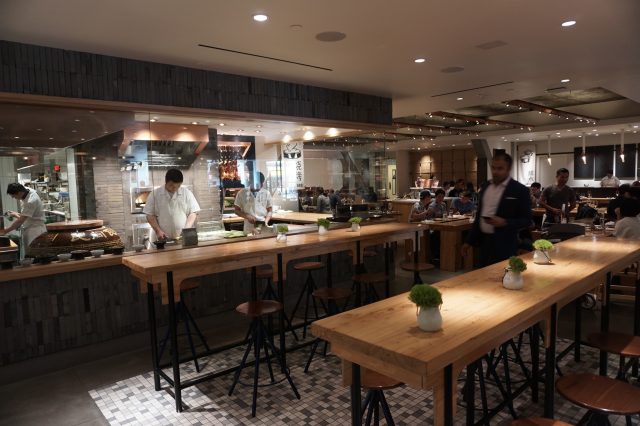
The dining room and charcuterie station of China Live’s Market Restaurant. | Photo: Joe Bonadio
We start with a tour of the Market Restaurant on the ground floor. Chen has spared no expense here, but don’t expect ostentation. The dining room feels modern without hewing to trends, employing lots of natural surfaces, including heavy tables of reclaimed Chinese white elm.
There are eight cooking stations positioned around the periphery of the room. At the charcuterie station, where amber roasted ducks hang gleaming at the ready, Chen points out a Chinese earthen oven, over 1,000 years old. It looks like the sort of huge vase you might see in a museum, and it’s used to maintain a very low, consistent heat that slowly draws the flavor out of complex soups. It’s also perfect for slow roasting pork–as we would soon find out.
[easy-tweet tweet=”Our ambition is to be one of the best restaurants, period. -George Chen, Owner of China Live” hashtags=”ChinaLive”]
At the dumpling station (where I typically like to dine), two solemn women tend to two huge cast iron pans. Periodically spinning the pans according to some innate schedule, they turn out some of the best potstickers, scallion pancakes, and other fried dumplings you can get anywhere.
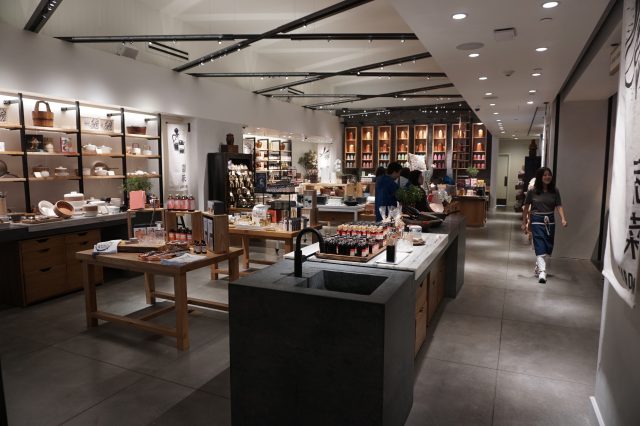
China Live’s stylish retail space carries many of the products used to create their cuisine. | Photo: Joe Bonadio
Just a few steps away, Chen gives the students a glimpse of some of the unusual products he carries on the retail side of the operation, an impressive and colorful multi-level space that abuts the main dining room. Of the several products Chen shows us, one stood out: extra-virgin tea oil. As Chen explains, tea oil is pressed just like olive oil, but using select tea leaves, and it’s ideal when you’re looking for a light oil without the Mediterranean character that olive oil imparts. Like many of the products he sells, the chef uses tea oil in the cuisine he prepares here.
Next, a quick flight of stairs leads us to Cold Drinks, which might be the coolest cocktail bar you’ve never heard of. An opulent, modern space meant to evoke the glamour of old Shanghai, Cold Drinks has no signage, and opened with no hype. So it feels like a secret, and with its tuxedo-clad barmen, it feels exclusive. The game here is scotch, and the bar boasts one of best selections I’ve seen. Anchored by a stunning black and white bar made from a single slab of exquisite marble, the space is a visual knockout.
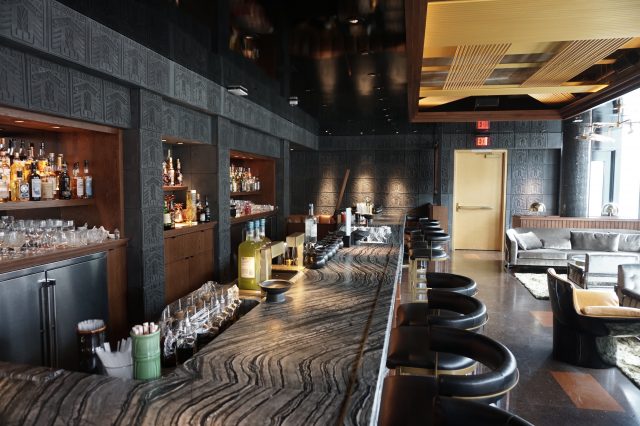
The handsome marble bar at China Live’s Cold Drinks Cocktail Lounge. | Photo: Joe Bonadio
Of course, just like the students, I am eager to get a look at the chef’s fine dining entry, Eight Tables By George Chen. The elevator requirs two trips to get us all up, but our group is soon breaching Eight Tables’ pristine cocktail area. I had gotten a glimpse of the space when it was nearing completion, and it’s even more impressive than the preview suggested. The attention to detail is staggering: in one finishing touch, antique lace taken from Chinese wedding dresses has been delicately pressed into plaster to create uniquely textured wall surfaces.
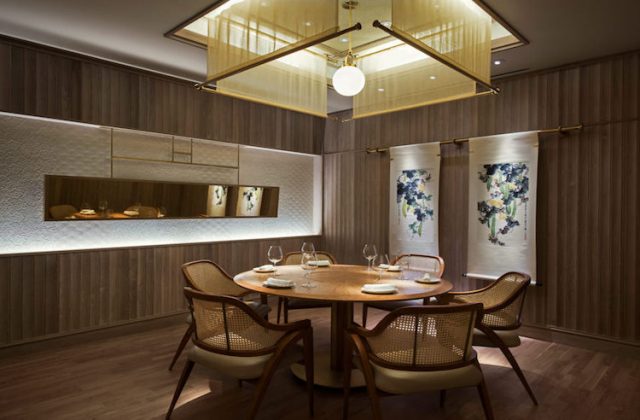
The transcendent Eight Tables By George Chen. | Photo Courtesy China Live
The kitchen is nearly as luxe, as suggestive of a laboratory as any kitchen I’ve ever seen. I notice a full roster of reservations for that evening posted on the wall: the prix fixe at Eight Tables is $225 and the optional pairings $125, but that has’t slowed the pace here.
The room is full of smart-looking young chefs, as spiffy as the stainless steel counters. They’ve just received a shipment of new spices, and the room has the air of Christmas morning. Removing the lid from a jar, Chen gives each of us a single green peppercorn, instructing us to hold them on our tongues–which immediately start tingling intensely. Then, setting the tone for the rest of the tour, he rushes ahead to the next destination, challenging the group to keep up.
We exit Eight Tables from the entrance, into a nondescript alley that opens to Vallejo Street, right next to Molinari’s Deli. It’s literally the line where North Beach meets Chinatown, and considering the audience, Chen couldn’t have started the tour at a better place. After a quick peek into Molinari’s to show the students our Italian bonafides, we head to Chinatown to begin the tour proper.
Chen does know how to please his guests, and one of our first stops is Golden Gate Bakery. Legendary for their warm egg tarts, GGB has been around for decades, and always has a line of hungry devotees snaking out the door. People are willing to wait half an hour or more for these egg tarts–but we are with George Chen, so somehow we walk right up to counter. And Golden Gate delivers the goods: delicate egg custard cradled in the flakiest of crusts, fresh and warm from the oven. If you haven’t, you must.

Beware all who enter here: the iconic neon sign at Chinatown’s Li Po Lounge. | Photo Courtesy Yelp
Sweeping crumbs from our sweaters, we head up Grant Avenue, Chen leading the pack. He keeps up a constant patter along the way, peppering the students with all manner of information, useful and arcane, on the historic Chinatown enclave. As we approach Li Po Lounge, a favorite cocktail spot of mine, I make a silent wish (it was almost 5:00, after all). Chen immediately grants it, veering left into the darkened interior of the tavern, fascinated students in tow.
Li Po Lounge has been here forever (or at least since 1935, it’s said), and looks it. The hanging lanterns, including one ancient, massive one above the bar, complement the red vinyl booths in just the right way, creating a retro-dive atmosphere that is unmatched. Chen knows what to drink here, and orders for everyone: Chinese Mai Tais, the classic Polynesian cocktail adulterated with something called “Chinese Whiskey.” They won’t sell us smalls, so we get eight for the sixteen of us and extra glasses, and split them up.
The drinks are delish, and this would have been a good spot to relax for a bit, but that’s for people who don’t have a book full of reservations. Accordingly, Chen gives his guests a brief rundown of the place, signs the check, and proceeds to slam his drink and head for the door. I have to laugh as I watch the group struggle to get their drinks down before the chef disappears down the next alleyway. Tick, tock!
Next, a stop at the The Wok Shop, where they’ve been selling woks (and just about anything else you can use in a kitchen) for over 40 years. The space probably has more merchandise per square foot than any store in Chinatown, and they know their stuff. George introduces us to the lively owner, Tang, who has apparently known Chen for most of his life. I mention that I had been to the shop before, and she quips with a smile: “I remember you. You never bought anything.”
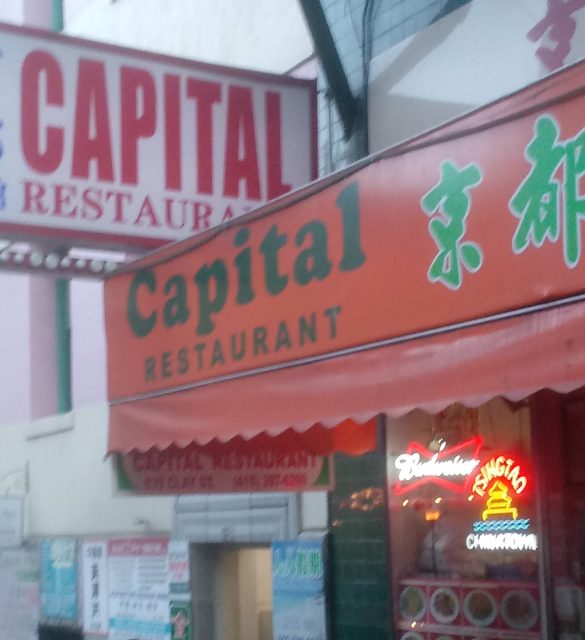
The nondescript Capital restaurant on Clay Street, now on my short list. | Photo: Joe Bonadio
After promising to return and buy a wok, we are off again. Time is dwindling, but Chen has a few more gems to reveal. We pop into the Far East Cafe, where he tells a tale of ancient bottles of hallucinogenic Fernet-Branca, dispensed from behind the bar in days past. We pass by the humble Capital restaurant, at which Chen cocks his thumb in approval (note to self). We take a spin around the Stockton Seafood Center, where they offer a dizzying array of exotica, including a dozen varieties of ginger, and dried abalone that sells for over $2,500 a pound.

Barrels of premium ginger at Stockton Seafood Center in Chinatown. | Photo: Joe Bonadio
Then, off again. Try to picture the sixteen of us, hurtling north on Stockton behind the voluble chef, weaving and curb-hopping our way through the rush-hour Chinatown throng.
Did I mention that we are having dinner at the end of this? I may have forgotten, but that is exactly what we are doing. George Chen isn’t going to let these culinary students go back to Italy without feeding them first. And I get to act as a surrogate host for the chef, who has to leave the group to don his kitchen whites.
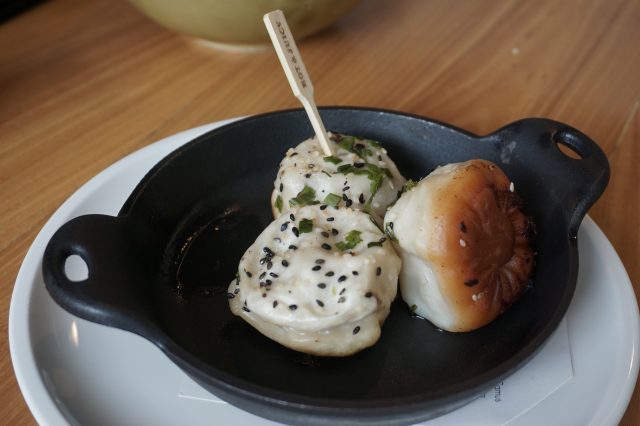
Sheng Jian Bao (Pan-fried Pork Dumplings) at China Live. | Photo: Joe Bonadio
With our tour guide now ensconced in the kitchen, we proceed to enjoy a truly lordly feast. We sample nearly every kind of dumpling, and there are many; the “Working Hands” dumplings in a spicy peppercorn broth is a new item for me, and a keeper. Crushed cucumber skins with chili vinaigrette is followed by chili prawns and some of the best char siu and Peking duck I’ve ever tasted.
And where I normally save my plaudits for the dumplings (I especially like the Dongbei veggie pot stickers), on this visit the standout is the crispy-skin roasted pork belly cubes (Siu Yuk). As much about crisp texture as it is about aroma and sublime flavor, this dish is simplicity itself.
Dessert, typically an afterthought at most Chinese restaurants, is the most exotic part of the meal. The egg tart is present, here in a bruléed version with caramelized apple; there is also an elaborate Valrhona chocolate coconut cake with milk tea shaved ice, served alongside sections of Mandarin orange. Both of these are impressive, but my favorite is the soy milk panna cotta with cassia honey and barley. Sigh.
As I bid farewell to the giddy students on the sidewalk in front of China Live, brimming with wine and delicious food, I feel grateful for the experience. These Italians are going to have a lot to report when they get back to Piemonte.
George Chen is trying to do something completely different with China Live, and he appears to be succeeding. And he’s not finished: they’ll soon be unveiling a rooftop lounge, the only one of its kind in the neighborhood. We’ll be following things closely here at Joe Content, so come back soon.